PART 1 - Python Tutorial | Variables and Data Types in Python
Download as pptx, pdf1 like546 views
Variables in python Rules for naming variables in python strings in python f strings in python integers in python float in python functions in python
1 of 64
Downloaded 47 times
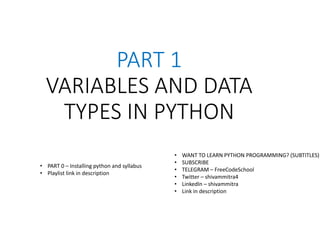
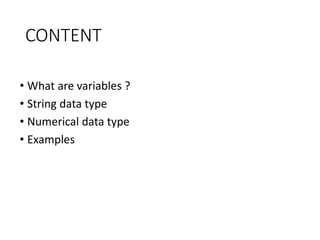



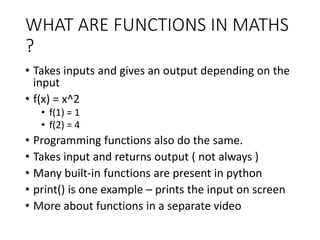




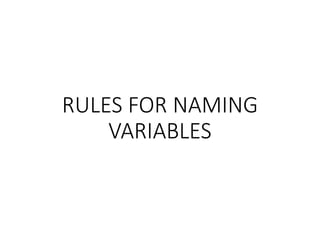

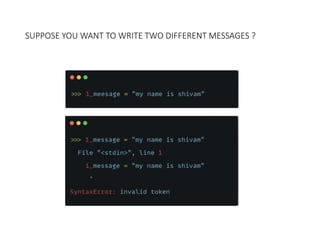





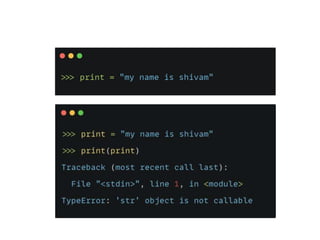










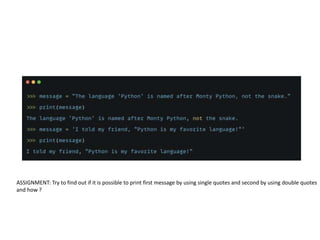








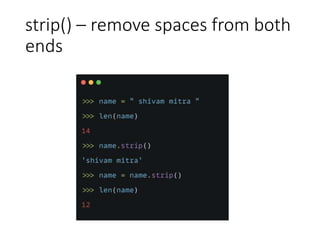








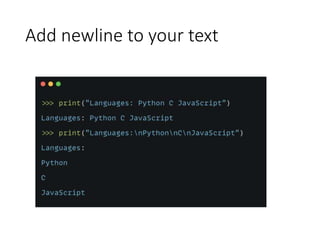







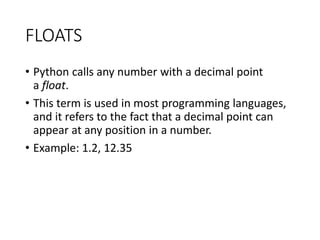



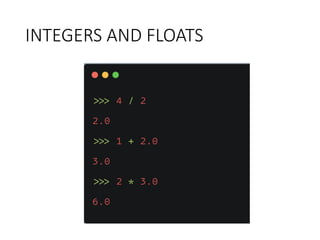




Ad
Recommended
Introduction to python for Beginners 



Introduction to python for Beginners Sujith Kumar Python is a general purpose programming language that can be used for both programming and scripting. It was created in the 1990s by Guido van Rossum who named it after the Monty Python comedy troupe. People use Python for a variety of tasks due to its readability, object-oriented capabilities, extensive libraries, and ability to integrate with other languages. To run Python code, it must first be compiled into bytecode which is then interpreted by the Python virtual machine.
Python Basics



Python Basicstusharpanda88 This document provides an introduction to the Python programming language. It covers Python's background, syntax, types, operators, control flow, functions, classes, tools, and IDEs. Key points include that Python is a multi-purpose, object-oriented language that is interpreted, strongly and dynamically typed. It focuses on readability and has a huge library of modules. Popular Python IDEs include Emacs, Vim, Komodo, PyCharm, and Eclipse.
Python Course | Python Programming | Python Tutorial | Python Training | Edureka



Python Course | Python Programming | Python Tutorial | Python Training | EdurekaEdureka! This Edureka Python tutorial is a part of Python Course (Python Tutorial Blog: https://goo.gl/wd28Zr) and will help you in understanding what exactly is Python and its various applications. It also explains few Python code basics like data types, operators etc. Below are the topics covered in this tutorial:
1. Introduction to Python
2. Various Python Features
3. Python Applications
4. Python for Web Scraping
5. Python for Testing
6. Python for Web Development
7. Python for Data Analysis
Variables in python



Variables in pythonJaya Kumari Variables in python- Describing Variable and assigning values, Object Reference, Object Identity, How to define Variables, Variable types
Python programming



Python programmingAshwin Kumar Ramasamy The document provides an introduction to Python programming. It discusses key concepts like variables, data types, operators, and sequential data types. Python is presented as an interpreted programming language that uses indentation to indicate blocks of code. Comments and documentation are included to explain the code. Various data types are covered, including numbers, strings, booleans, and lists. Operators for arithmetic, comparison, assignment and more are also summarized.
Regular expressions in Python



Regular expressions in PythonSujith Kumar Regular expressions are a powerful tool for searching, matching, and parsing text patterns. They allow complex text patterns to be matched with a standardized syntax. All modern programming languages include regular expression libraries. Regular expressions can be used to search strings, replace parts of strings, split strings, and find all occurrences of a pattern in a string. They are useful for tasks like validating formats, parsing text, and finding/replacing text. This document provides examples of common regular expression patterns and methods for using regular expressions in Python.
Python pandas Library



Python pandas LibraryMd. Sohag Miah This document provides an overview of Pandas, a Python library used for data analysis and manipulation. Pandas allows users to manage, clean, analyze and model data. It organizes data in a form suitable for plotting or displaying tables. Key data structures in Pandas include Series for 1D data and DataFrame for 2D (tabular) data. DataFrames can be created from various inputs and Pandas includes input/output tools to read data from files into DataFrames.
Transformer in Vision



Transformer in VisionSangmin Woo Transformer Architectures in Vision
[2018 ICML] Image Transformer
[2019 CVPR] Video Action Transformer Network
[2020 ECCV] End-to-End Object Detection with Transformers
[2021 ICLR] An Image is Worth 16x16 Words: Transformers for Image Recognition at Scale
Python made easy 



Python made easy Abhishek kumar This document provides an introduction and overview of the Python programming language. It discusses what Python is, its features, applications, and how to install Python on Windows and Linux systems. It also covers Python basics like variables, data types, operators, comments, conditional statements like if/else, and loops like for, while, and nested loops. Examples are provided for key concepts. The document is intended as a beginner tutorial for learning Python.
PART 7 - Python Tutorial | Dictionaries In Python With Examples



PART 7 - Python Tutorial | Dictionaries In Python With ExamplesShivam Mitra Python Tutorial
Python tutorial for beginners
Learn Python Programming
Python3 Tutorial
Python programming tutorial
Python youtube tutorial
Python online tutorial
Best Python Tutorial on Youtube
Jobs for python programmers
stackoverflow survey
Best Python tutorial
Best Python course
Python full course
Python job interview
Python job for fresher
Python job salary in India
Introduction To Python | Edureka



Introduction To Python | EdurekaEdureka! ** Python Certification Training: https://www.edureka.co/python **
This Edureka PPT on 'Introduction To Python' will help you establish a strong hold on all the fundamentals in the Python programming language. Below are the topics covered in this PPT:
Introduction To Python
Keywords And Identifiers
Variables And Data Types
Operators
Loops In Python
Functions
Classes And Objects
OOPS Concepts
File Handling
YouTube Video: https://youtu.be/uYjRzbP5aZs
Python Tutorial Playlist: https://goo.gl/WsBpKe
Blog Series: http://bit.ly/2sqmP4s
Follow us to never miss an update in the future.
YouTube: https://www.youtube.com/user/edurekaIN
Instagram: https://www.instagram.com/edureka_learning/
Facebook: https://www.facebook.com/edurekaIN/
Twitter: https://twitter.com/edurekain
LinkedIn: https://www.linkedin.com/company/edureka
PART 3 - Python Tutorial | For Loop In Python With Examples



PART 3 - Python Tutorial | For Loop In Python With ExamplesShivam Mitra This document discusses Python for loops and lists. It covers iterating through lists with for loops, avoiding indentation errors, creating numerical lists with the range function, slicing lists to access subsets of elements, copying lists, and using list comprehensions. Examples are provided like printing a multiplication table using a one-line list comprehension and slicing a fruits list to print elements at odd and even positions.
Beginning Python Programming



Beginning Python ProgrammingSt. Petersburg College Python is a widely-used and powerful computer programming language that has helped system administrators manage computer networks and problem solve computer systems for decades. Python has also built some popular applications like BitTorrent, Blender, Calibre, Dropbox, and much more. Going further, the “Pi” in Raspberry Pi stands for Python, so learning Python will instill more confidence when working with Raspberry Pi projects. Python is usually the first programming language people learn primarily because it is easy to learn and provides a solid foundation to learn other computer programming languages. In this webinar,
• Learn what Python is and what it is capable of doing.
• Install Python’s IDE for Windows and work in the Python shell.
• Use calculations, variables, strings, lists, and if statements.
• Discover Python’s built-in functions and understand modules.
• Create simple programs to build on later.
The recording is available at https://youtu.be/ThcWmJFf-ho.
Python Functions



Python FunctionsMohammed Sikander Python functions allow for reusable code through defining functions, passing arguments, returning values, and setting scopes. Functions can take positional or keyword arguments, as well as variable length arguments. Default arguments allow functions to specify default values for optional parameters. Functions are objects that can be assigned to variables and referenced later.
Python Tutorial Part 1



Python Tutorial Part 1Haitham El-Ghareeb This document provides an agenda and overview for a Python tutorial presented over multiple sessions. The first session introduces Python and demonstrates how to use the Python interpreter. The second session covers basic Python data structures like lists, modules, input/output, and exceptions. An optional third session discusses unit testing. The document explains that Python is an easy to learn yet powerful programming language that supports object-oriented programming and high-level data structures in an interpreted, dynamic environment.
Chapter 1 - INTRODUCTION TO PYTHON -MAULIK BORSANIYA



Chapter 1 - INTRODUCTION TO PYTHON -MAULIK BORSANIYAMaulik Borsaniya Introduction to Python:
The basic elements of Python, Objects, expressions and numerical Types, Variables and assignments, IDLE, Branching programs, Strings and Input, Iteration
Structured Types, Mutability and Higher-order Functions:
Tuples, Lists and Mutability, Functions as Objects, Strings, Tuples and Lists, Dictionaries
Introduction to python



Introduction to pythonMaheshPandit16 Python strings are sequences of characters that can be accessed and manipulated using various string methods. Strings can be declared using either single or double quotes and support escape characters. Strings are immutable and concatenation creates a new string. Common string methods include len() to get the length, lower()/upper() to case conversion, strip() to remove whitespace, and startswith()/endswith() to check substrings.
Introduction to python



Introduction to pythonAyshwarya Baburam This document provides an overview of the Python programming language. It discusses what Python is, its key features, who uses it, common applications, and how to download and install Python. It then covers Python syntax concepts like identifiers, keywords, multiline statements, docstrings, indentation, comments, and string formatting. The document also introduces Python data types like numbers, strings, lists, tuples, dictionaries, sets and how to work with them. It describes how to convert between number types and access/update strings and lists. Finally, it discusses Python development environments like Anaconda and Spyder.
Python Loops Tutorial | Python For Loop | While Loop Python | Python Training...



Python Loops Tutorial | Python For Loop | While Loop Python | Python Training...Edureka! This document discusses loops in Python. It begins by explaining why loops are useful, such as for payroll processing to calculate salaries and bonuses for multiple employees. It then defines loops as allowing code to execute repeatedly based on conditional statements. The document outlines the main types of loops in Python - while loops, for loops, and nested loops. While loops iterate until a condition is false, for loops iterate a specified number of times, and nested loops involve loops within other loops. Examples are provided for each loop type, such as a guessing game to demonstrate a while loop and calculating factorials with a for loop.
Pointers in C



Pointers in CMonishkanungo The document discusses pointers in C programming. It defines pointers as variables that store memory addresses and can point to data of various types, such as integers, characters, arrays, functions, and other pointers. It explains how to declare pointers, dereference pointers to access data, use pointers as function arguments, perform arithmetic on pointers, and use pointers to structures. Pointers allow accessing data indirectly through memory addresses, provide flexibility in passing arguments to functions, and are fundamental to working with arrays and structures in C.
Python variables and data types.pptx



Python variables and data types.pptxAkshayAggarwal79 This document discusses Python variables and data types. It defines what a Python variable is and explains variable naming rules. The main Python data types are numbers, strings, lists, tuples, dictionaries, booleans, and sets. Numbers can be integer, float or complex values. Strings are sequences of characters. Lists are mutable sequences that can hold elements of different data types. Tuples are immutable sequences. Dictionaries contain key-value pairs with unique keys. Booleans represent True and False values. Sets are unordered collections of unique elements. Examples are provided to demonstrate how to declare variables and use each of the different data types in Python.
Part 2 - Python Tutorial | Introduction to Lists



Part 2 - Python Tutorial | Introduction to ListsShivam Mitra Python Tutorial
Python tutorial for beginners
Learn Python Programming
Python3 Tutorial
Python programming tutorial
Python youtube tutorial
Python online tutorial
Best Python Tutorial on Youtube
Jobs for python programmers
stackoverflow survey
Best Python tutorial
Best Python course
Python full course
Python job interview
Python job for fresher
Python job salary in India
Phython Programming Language



Phython Programming LanguageR.h. Himel Python is an interpreted, object-oriented, high-level programming language with dynamic semantics. Its high-level built in data structures, combined with dynamic typing and dynamic binding, make it very attractive for Rapid Application Development, as well as for use as a scripting or glue language to connect existing components together. Python's simple, easy to learn syntax emphasizes readability and therefore reduces the cost of program maintenance. Python supports modules and packages, which encourages program modularity and code reuse. The Python interpreter and the extensive standard library are available in source or binary form without charge for all major platforms, and can be freely distributed.
Python - Numpy/Pandas/Matplot Machine Learning Libraries



Python - Numpy/Pandas/Matplot Machine Learning LibrariesAndrew Ferlitsch Abstract: This PDSG workshop introduces the basics of Python libraries used in machine learning. Libraries covered are Numpy, Pandas and MathlibPlot.
Level: Fundamental
Requirements: One should have some knowledge of programming and some statistics.
Python



PythonSangita Panchal This document provides an introduction to Python programming concepts including data types, operators, control flow statements, functions and modules. It discusses the basic Python data types like integers, floats, booleans, strings, lists, tuples, dictionaries and sets. It also covers Python operators like arithmetic, assignment, comparison, logical and identity operators. Additionally, it describes control flow statements like if/else and for loops. Finally, it touches on functions, modules and input/output statements in Python.
Strings in Python



Strings in PythonAmisha Narsingani Strings in Python can be created using single quotes, double quotes, or triple quotes. Strings are immutable and indexing allows accessing individual characters. Strings can be sliced to extract substrings. The + operator is used for concatenation and * operator repeats strings. The split method returns a list of substrings split by a delimiter and join method concatenates strings with a delimiter.
Looping Statements and Control Statements in Python



Looping Statements and Control Statements in PythonPriyankaC44 This document discusses looping statements and control statements in Python. It explains while loops, for loops, and the use of break, continue, else and pass statements. Some key points:
- While loops repeatedly execute statements as long as a condition is true. For loops iterate over a sequence.
- Break and continue statements can alter loop flow - break exits the entire loop, continue skips to the next iteration.
- The else block in loops runs when the condition becomes false (while) or the sequence is complete (for).
- Pass is a null operation used when syntax requires a statement but no operation is needed.
Several examples of loops and control statements are provided to demonstrate their usage.
Python - An Introduction



Python - An IntroductionSwarit Wadhe Python An Introduction, A presentation Developed by Swarit Wadhe. This Slide Will Give you basic information about python (Origin, Codes and difference from other languages).
I hope you'll find this helpfull and if you do please share it with your fellows.
VARIABLES AND DATA TYPES IN PYTHON NEED TO STUDY



VARIABLES AND DATA TYPES IN PYTHON NEED TO STUDYRushikesh Kolhe This document discusses variables and data types in Python. It introduces variables as symbols that represent values that can change. It describes the main data types in Python including strings, numerical data types (integers and floats), and provides examples of how to work with each data type. It covers naming conventions for variables, built-in functions for strings like upper(), lower(), len(), and how to perform operations on numerical data types.
20BCT23 – PYTHON PROGRAMMING.pptx



20BCT23 – PYTHON PROGRAMMING.pptxgokilabrindha The document discusses various topics in Python programming including literal constants, numbers, strings, variables, data types, operators, and expressions. It defines literal constants as values that cannot be changed and lists examples. It describes the different number types in Python and issues with floating point numbers. It also covers formatting numbers, simple numeric operations, strings, variable naming rules, data types, assigning values, comments, and indentation in Python code.
More Related Content
What's hot (20)
Python made easy 



Python made easy Abhishek kumar This document provides an introduction and overview of the Python programming language. It discusses what Python is, its features, applications, and how to install Python on Windows and Linux systems. It also covers Python basics like variables, data types, operators, comments, conditional statements like if/else, and loops like for, while, and nested loops. Examples are provided for key concepts. The document is intended as a beginner tutorial for learning Python.
PART 7 - Python Tutorial | Dictionaries In Python With Examples



PART 7 - Python Tutorial | Dictionaries In Python With ExamplesShivam Mitra Python Tutorial
Python tutorial for beginners
Learn Python Programming
Python3 Tutorial
Python programming tutorial
Python youtube tutorial
Python online tutorial
Best Python Tutorial on Youtube
Jobs for python programmers
stackoverflow survey
Best Python tutorial
Best Python course
Python full course
Python job interview
Python job for fresher
Python job salary in India
Introduction To Python | Edureka



Introduction To Python | EdurekaEdureka! ** Python Certification Training: https://www.edureka.co/python **
This Edureka PPT on 'Introduction To Python' will help you establish a strong hold on all the fundamentals in the Python programming language. Below are the topics covered in this PPT:
Introduction To Python
Keywords And Identifiers
Variables And Data Types
Operators
Loops In Python
Functions
Classes And Objects
OOPS Concepts
File Handling
YouTube Video: https://youtu.be/uYjRzbP5aZs
Python Tutorial Playlist: https://goo.gl/WsBpKe
Blog Series: http://bit.ly/2sqmP4s
Follow us to never miss an update in the future.
YouTube: https://www.youtube.com/user/edurekaIN
Instagram: https://www.instagram.com/edureka_learning/
Facebook: https://www.facebook.com/edurekaIN/
Twitter: https://twitter.com/edurekain
LinkedIn: https://www.linkedin.com/company/edureka
PART 3 - Python Tutorial | For Loop In Python With Examples



PART 3 - Python Tutorial | For Loop In Python With ExamplesShivam Mitra This document discusses Python for loops and lists. It covers iterating through lists with for loops, avoiding indentation errors, creating numerical lists with the range function, slicing lists to access subsets of elements, copying lists, and using list comprehensions. Examples are provided like printing a multiplication table using a one-line list comprehension and slicing a fruits list to print elements at odd and even positions.
Beginning Python Programming



Beginning Python ProgrammingSt. Petersburg College Python is a widely-used and powerful computer programming language that has helped system administrators manage computer networks and problem solve computer systems for decades. Python has also built some popular applications like BitTorrent, Blender, Calibre, Dropbox, and much more. Going further, the “Pi” in Raspberry Pi stands for Python, so learning Python will instill more confidence when working with Raspberry Pi projects. Python is usually the first programming language people learn primarily because it is easy to learn and provides a solid foundation to learn other computer programming languages. In this webinar,
• Learn what Python is and what it is capable of doing.
• Install Python’s IDE for Windows and work in the Python shell.
• Use calculations, variables, strings, lists, and if statements.
• Discover Python’s built-in functions and understand modules.
• Create simple programs to build on later.
The recording is available at https://youtu.be/ThcWmJFf-ho.
Python Functions



Python FunctionsMohammed Sikander Python functions allow for reusable code through defining functions, passing arguments, returning values, and setting scopes. Functions can take positional or keyword arguments, as well as variable length arguments. Default arguments allow functions to specify default values for optional parameters. Functions are objects that can be assigned to variables and referenced later.
Python Tutorial Part 1



Python Tutorial Part 1Haitham El-Ghareeb This document provides an agenda and overview for a Python tutorial presented over multiple sessions. The first session introduces Python and demonstrates how to use the Python interpreter. The second session covers basic Python data structures like lists, modules, input/output, and exceptions. An optional third session discusses unit testing. The document explains that Python is an easy to learn yet powerful programming language that supports object-oriented programming and high-level data structures in an interpreted, dynamic environment.
Chapter 1 - INTRODUCTION TO PYTHON -MAULIK BORSANIYA



Chapter 1 - INTRODUCTION TO PYTHON -MAULIK BORSANIYAMaulik Borsaniya Introduction to Python:
The basic elements of Python, Objects, expressions and numerical Types, Variables and assignments, IDLE, Branching programs, Strings and Input, Iteration
Structured Types, Mutability and Higher-order Functions:
Tuples, Lists and Mutability, Functions as Objects, Strings, Tuples and Lists, Dictionaries
Introduction to python



Introduction to pythonMaheshPandit16 Python strings are sequences of characters that can be accessed and manipulated using various string methods. Strings can be declared using either single or double quotes and support escape characters. Strings are immutable and concatenation creates a new string. Common string methods include len() to get the length, lower()/upper() to case conversion, strip() to remove whitespace, and startswith()/endswith() to check substrings.
Introduction to python



Introduction to pythonAyshwarya Baburam This document provides an overview of the Python programming language. It discusses what Python is, its key features, who uses it, common applications, and how to download and install Python. It then covers Python syntax concepts like identifiers, keywords, multiline statements, docstrings, indentation, comments, and string formatting. The document also introduces Python data types like numbers, strings, lists, tuples, dictionaries, sets and how to work with them. It describes how to convert between number types and access/update strings and lists. Finally, it discusses Python development environments like Anaconda and Spyder.
Python Loops Tutorial | Python For Loop | While Loop Python | Python Training...



Python Loops Tutorial | Python For Loop | While Loop Python | Python Training...Edureka! This document discusses loops in Python. It begins by explaining why loops are useful, such as for payroll processing to calculate salaries and bonuses for multiple employees. It then defines loops as allowing code to execute repeatedly based on conditional statements. The document outlines the main types of loops in Python - while loops, for loops, and nested loops. While loops iterate until a condition is false, for loops iterate a specified number of times, and nested loops involve loops within other loops. Examples are provided for each loop type, such as a guessing game to demonstrate a while loop and calculating factorials with a for loop.
Pointers in C



Pointers in CMonishkanungo The document discusses pointers in C programming. It defines pointers as variables that store memory addresses and can point to data of various types, such as integers, characters, arrays, functions, and other pointers. It explains how to declare pointers, dereference pointers to access data, use pointers as function arguments, perform arithmetic on pointers, and use pointers to structures. Pointers allow accessing data indirectly through memory addresses, provide flexibility in passing arguments to functions, and are fundamental to working with arrays and structures in C.
Python variables and data types.pptx



Python variables and data types.pptxAkshayAggarwal79 This document discusses Python variables and data types. It defines what a Python variable is and explains variable naming rules. The main Python data types are numbers, strings, lists, tuples, dictionaries, booleans, and sets. Numbers can be integer, float or complex values. Strings are sequences of characters. Lists are mutable sequences that can hold elements of different data types. Tuples are immutable sequences. Dictionaries contain key-value pairs with unique keys. Booleans represent True and False values. Sets are unordered collections of unique elements. Examples are provided to demonstrate how to declare variables and use each of the different data types in Python.
Part 2 - Python Tutorial | Introduction to Lists



Part 2 - Python Tutorial | Introduction to ListsShivam Mitra Python Tutorial
Python tutorial for beginners
Learn Python Programming
Python3 Tutorial
Python programming tutorial
Python youtube tutorial
Python online tutorial
Best Python Tutorial on Youtube
Jobs for python programmers
stackoverflow survey
Best Python tutorial
Best Python course
Python full course
Python job interview
Python job for fresher
Python job salary in India
Phython Programming Language



Phython Programming LanguageR.h. Himel Python is an interpreted, object-oriented, high-level programming language with dynamic semantics. Its high-level built in data structures, combined with dynamic typing and dynamic binding, make it very attractive for Rapid Application Development, as well as for use as a scripting or glue language to connect existing components together. Python's simple, easy to learn syntax emphasizes readability and therefore reduces the cost of program maintenance. Python supports modules and packages, which encourages program modularity and code reuse. The Python interpreter and the extensive standard library are available in source or binary form without charge for all major platforms, and can be freely distributed.
Python - Numpy/Pandas/Matplot Machine Learning Libraries



Python - Numpy/Pandas/Matplot Machine Learning LibrariesAndrew Ferlitsch Abstract: This PDSG workshop introduces the basics of Python libraries used in machine learning. Libraries covered are Numpy, Pandas and MathlibPlot.
Level: Fundamental
Requirements: One should have some knowledge of programming and some statistics.
Python



PythonSangita Panchal This document provides an introduction to Python programming concepts including data types, operators, control flow statements, functions and modules. It discusses the basic Python data types like integers, floats, booleans, strings, lists, tuples, dictionaries and sets. It also covers Python operators like arithmetic, assignment, comparison, logical and identity operators. Additionally, it describes control flow statements like if/else and for loops. Finally, it touches on functions, modules and input/output statements in Python.
Strings in Python



Strings in PythonAmisha Narsingani Strings in Python can be created using single quotes, double quotes, or triple quotes. Strings are immutable and indexing allows accessing individual characters. Strings can be sliced to extract substrings. The + operator is used for concatenation and * operator repeats strings. The split method returns a list of substrings split by a delimiter and join method concatenates strings with a delimiter.
Looping Statements and Control Statements in Python



Looping Statements and Control Statements in PythonPriyankaC44 This document discusses looping statements and control statements in Python. It explains while loops, for loops, and the use of break, continue, else and pass statements. Some key points:
- While loops repeatedly execute statements as long as a condition is true. For loops iterate over a sequence.
- Break and continue statements can alter loop flow - break exits the entire loop, continue skips to the next iteration.
- The else block in loops runs when the condition becomes false (while) or the sequence is complete (for).
- Pass is a null operation used when syntax requires a statement but no operation is needed.
Several examples of loops and control statements are provided to demonstrate their usage.
Python - An Introduction



Python - An IntroductionSwarit Wadhe Python An Introduction, A presentation Developed by Swarit Wadhe. This Slide Will Give you basic information about python (Origin, Codes and difference from other languages).
I hope you'll find this helpfull and if you do please share it with your fellows.
Similar to PART 1 - Python Tutorial | Variables and Data Types in Python (20)
VARIABLES AND DATA TYPES IN PYTHON NEED TO STUDY



VARIABLES AND DATA TYPES IN PYTHON NEED TO STUDYRushikesh Kolhe This document discusses variables and data types in Python. It introduces variables as symbols that represent values that can change. It describes the main data types in Python including strings, numerical data types (integers and floats), and provides examples of how to work with each data type. It covers naming conventions for variables, built-in functions for strings like upper(), lower(), len(), and how to perform operations on numerical data types.
20BCT23 – PYTHON PROGRAMMING.pptx



20BCT23 – PYTHON PROGRAMMING.pptxgokilabrindha The document discusses various topics in Python programming including literal constants, numbers, strings, variables, data types, operators, and expressions. It defines literal constants as values that cannot be changed and lists examples. It describes the different number types in Python and issues with floating point numbers. It also covers formatting numbers, simple numeric operations, strings, variable naming rules, data types, assigning values, comments, and indentation in Python code.
Python (Data Analysis) cleaning and visualize



Python (Data Analysis) cleaning and visualizeIruolagbePius This document provides an overview of Python programming language. It discusses Python features, uses, variables, data types, operators, decision making statements, and loops. Specifically, it covers:
- Python features like being easy to learn and read, having an interactive mode, and being portable.
- Python variables, naming rules, and basic data types like numbers, strings, booleans.
- Operators for arithmetic, comparison, assignment, and logic.
- Conditional statements like if, elif, else for decision making.
- Looping structures like while and for loops, with examples of using break, continue, else, range().
- How to write comments, take user input, and
Python Data Types



Python Data Typesathithanvijay This document provides an introduction to the Python programming language. It discusses Python language elements like literals, keywords, identifiers, operators, expressions, statements, and comments. It also covers Python data types, variables, printing values, and how to write and run a simple Python program. The document aims to explain Python concepts in a step-by-step manner to help readers learn the basics of the Python language.
Fundamentals of Python Programming



Fundamentals of Python ProgrammingKamal Acharya The document provides an introduction to Python programming including its features, uses, history, and installation process. Some key points covered include:
- Python is an interpreted, object-oriented programming language that is used for web development, scientific computing, and desktop applications.
- It was created by Guido van Rossum in 1991 and named after the Monty Python comedy group.
- To install Python on Windows, users download the latest version from python.org and run the installer, which also installs the IDLE development environment.
- The document then covers basic Python concepts like variables, data types, operators, and input/output functions.
Python Programming



Python ProgrammingSaravanan T.M The document provides an introduction to Python programming. It discusses that Python is a high-level, interpreted, object-oriented, and general purpose programming language. It can be used for web development, scientific computing, desktop applications, and more. The document then covers Python basics like data types, variables, literals, operators, control flow statements, functions, modules and packages. It also discusses installing Python on Windows and writing the first Python program.
BASICS OF PYTHON usefull for the student who would like to learn on their own



BASICS OF PYTHON usefull for the student who would like to learn on their ownNandini485510 for the student s who would like to learn basic of python
Basics of Python Programming



Basics of Python ProgrammingManishJha237 The document discusses Python programming concepts like variables, data types, operators, conditional statements and indentation. It explains that variables store and label data in memory, common data types like integers, floats and strings, basic arithmetic and assignment operators, if/else conditional statements and how Python uses indentation to group blocks of code. It also provides examples of type casting between different data types and prompts for writing Python programs to perform various comparisons and calculations.
Python Programming 1.pptx



Python Programming 1.pptxFrancis Densil Raj Python is an interpreted, interactive, object-oriented programming language. It has a simple syntax and is used for rapid application development. Python supports procedural, object-oriented, and functional programming. It has a large standard library and can connect to existing components. Python is easy to read and maintain due to its clear syntax and structure. It is also portable and has broad library support.
python_class.pptx



python_class.pptxchandankumar943868 - The document discusses Python programming concepts such as data types, variables, operators, and syntax. It provides examples of Python code for variables, comments, strings, numbers, and more.
- Python is a popular programming language used for web development, software development, mathematics, and more. It runs on different platforms and has a simple, readable syntax.
- Key features of Python include dynamic typing, automatic memory management, and an intuitive syntax that uses indentation rather than brackets.
CODING WITH PYTHON PART 1



CODING WITH PYTHON PART 1Buxoo Abdullah This explanation is the basic steps in learning python for beginners. Any student wishing to learn python can do so and practice this simple to use tutoril. Any feedback, suggestions or clarifications can be made to [email protected]. For G9, G10 and especially G11 students taking computer science [2210].
Python 01.pptx



Python 01.pptxAliMohammadAmiri Python is a cross-platform programming language that can run on Windows, macOS, Linux, and other platforms. It is free and open-source. While most modern operating systems come with Python pre-installed, it is generally recommended to install the latest version separately. The Thonny IDE is a simple Python IDE that bundles the latest Python version, so it can run Python programs without requiring a separate Python installation. Thonny has features like an easy-to-use debugger and code completion that make it suitable for beginners learning Python.
parts_of_python_programming_language.pptx



parts_of_python_programming_language.pptxKoteswari Kasireddy Python identifiers follow some basic rules:
1. They can include letters, numbers, and underscores.
2. They cannot start with a number.
3. Keywords like "if" cannot be used.
4. Identifiers are case-sensitive.
Of the given options, valid Python identifiers include: total1234, _abc_abc_, _p. Invalid ones include: 123total (can't start with number), java2share (contains special character), ca$h (contains special character), def (is a keyword).
Pythonintro



PythonintroHardik Malhotra This document provides an introduction to the Python programming language. It covers Python's basic data types like integers, floats, strings and lists. It also discusses functions, conditionals, loops, modules and libraries. Example code is provided to demonstrate Python syntax for variables, arithmetic, string operations, conditionals, functions and more. Key aspects of Python like dynamic typing, indentation, comments and documentation strings are also explained.
#Code2Create: Python Basics



#Code2Create: Python BasicsGDGKuwaitGoogleDevel The document provides instructions for downloading and installing Python and PyCharm on Mac and Windows systems. It outlines the steps to download each program from their respective websites, then guides the user through installing Python and PyCharm on their device by navigating folders and clicking through installation windows. It also briefly introduces some basic programming concepts that will be covered in an upcoming Python tutorial, such as variables, data types, conditional statements, and loops.
Python Data Types with realistical approach.pptx



Python Data Types with realistical approach.pptxMuhammadUmar890FETBS This document provides an overview of Python data types including strings, integers, floats, Booleans, lists and dictionaries. It discusses how to define and manipulate variables of each data type in Python. For strings, it describes how to get input from the user, change case, concatenate and add whitespace. For numbers, it covers arithmetic operations on integers and floats. It also discusses determining a variable's type, dynamic typing in Python, accessing, modifying and adding/removing elements from lists.
AmI 2015 - Python basics



AmI 2015 - Python basicsLuigi De Russis Introduction to the Python programming language (version 2.x)
Ambient intelligence: technology and design
http://bit.ly/polito-ami
Politecnico di Torino, 2015
Ad
More from Shivam Mitra (18)
Preparing for SRE Interviews



Preparing for SRE InterviewsShivam Mitra 1. Intro to SRE role
2. SRE vs DevOps vs SDE
3. How to prepare for SRE interviews ?
4. What specific skills to acquire for working as a SRE ?
5. How should we start our career as SRE straight out of college?
6. Study materials that can help
PART 4 - Python Tutorial | If Else In Python With Examples



PART 4 - Python Tutorial | If Else In Python With ExamplesShivam Mitra Python Tutorial
Python tutorial for beginners
Learn Python Programming
Python3 Tutorial
Python programming tutorial
Python youtube tutorial
Python online tutorial
Best Python Tutorial on Youtube
Jobs for python programmers
stackoverflow survey
Best Python tutorial
Best Python course
Python full course
Python job interview
Python job for fresher
Python job salary in India
PART 9 - Python Tutorial | While Loop In Python With Examples



PART 9 - Python Tutorial | While Loop In Python With ExamplesShivam Mitra The document discusses while loops in Python. It covers using while loops to count from 1 to 5, letting the user choose when to quit, using flags and breaks to exit loops, using continue to skip iterations, avoiding infinite loops, using while loops with lists to modify them, getting user input to populate lists and dictionaries, and removing values from lists.
PART 8 - Python Tutorial | User Input In Python With Examples



PART 8 - Python Tutorial | User Input In Python With ExamplesShivam Mitra Python Tutorial
Python tutorial for beginners
Learn Python Programming
Python3 Tutorial
Python programming tutorial
Python youtube tutorial
Python online tutorial
Best Python Tutorial on Youtube
Jobs for python programmers
stackoverflow survey
Best Python tutorial
Best Python course
Python full course
Python job interview
Python job for fresher
Python job salary in India
PART 6 - Python Tutorial | Tuples In Python With Examples



PART 6 - Python Tutorial | Tuples In Python With ExamplesShivam Mitra Python Tutorial
Python tutorial for beginners
Learn Python Programming
Python3 Tutorial
Python programming tutorial
Python youtube tutorial
Python online tutorial
Best Python Tutorial on Youtube
Jobs for python programmers
stackoverflow survey
Best Python tutorial
Best Python course
Python full course
Python job interview
Python job for fresher
Python job salary in India
PART 10 - Python Tutorial | Functions In Python With Examples



PART 10 - Python Tutorial | Functions In Python With ExamplesShivam Mitra Python Tutorial
Python tutorial for beginners
Learn Python Programming
Python3 Tutorial
Python programming tutorial
Python youtube tutorial
Python online tutorial
Best Python Tutorial on Youtube
Jobs for python programmers
stackoverflow survey
Best Python tutorial
Best Python course
Python full course
Python job interview
Python job for fresher
Python job salary in India
PART 0 - Python Tutorial | Why should you learn python



PART 0 - Python Tutorial | Why should you learn pythonShivam Mitra Python Tutorial
Python tutorial for beginners
Learn Python Programming
Python3 Tutorial
Python programming tutorial
Python youtube tutorial
Python online tutorial
Best Python Tutorial on Youtube
Jobs for python programmers
stackoverflow survey
Best Python tutorial
Best Python course
Python full course
Python job interview
Python job for fresher
Python job salary in India
Memory management in operating system | Paging | Virtual memory



Memory management in operating system | Paging | Virtual memoryShivam Mitra This document discusses memory management techniques in operating systems. It begins by covering contiguous memory allocation approaches like fixed and variable partitioning. It then discusses non-contiguous techniques like paging and segmentation. Key concepts covered include logical vs physical addresses, page tables, translation lookaside buffers, demand paging, and virtual memory. The document provides examples and links to detailed video explanations of these important OS memory management topics.
Process Synchronization in operating system | mutex | semaphore | race condition



Process Synchronization in operating system | mutex | semaphore | race conditionShivam Mitra 1. Race condition and critical section problem
2. Software and hardware solutions to critical section problem
3. Mutex and semaphore
4. Producer-consumer and reader writer problem
5. Deadlock in operating system
Process Scheduling Algorithms | Interviews | Operating system



Process Scheduling Algorithms | Interviews | Operating systemShivam Mitra IO Bound Process vs CPU Bound process
Types of scheduling queues and schedulers
Preemptive vs Nonpreemptive scheduling
Role of Dispatcher
Context Switch
Scheduling criteria
Scheduling algorithms ( FCFS, SJF, SRTF, Priority, Round Robin)
Multilevel Queue Scheduling
Threads in Operating System | Multithreading | Interprocess Communication



Threads in Operating System | Multithreading | Interprocess CommunicationShivam Mitra This document provides an introduction to threads. It discusses the differences between processes and threads, how threads are implemented in Linux, and challenges with multithreading like race conditions. Interprocess communication methods like shared memory and message passing are also covered. The benefits of multithreading include improved responsiveness and resource sharing. Multiprocessing uses multiple CPU cores to run programs in parallel while multithreading shares memory between threads.
Process management in operating system | process states | PCB | FORK() | Zomb...



Process management in operating system | process states | PCB | FORK() | Zomb...Shivam Mitra This is the second part of the operating system interview series.
In this session, we will look at the following:
1. Program vs process
2. Process states
3. Process control block
4. Process lifecycle using fork(), exec(), exit() and wait()
5. Zombie and orphan process
Introduction to operating system, system calls and interrupts



Introduction to operating system, system calls and interruptsShivam Mitra 1.Topics to focus for OS interviews
2. Introduction to operating system with architecture diagram
3. Operating system vs Kernel
4. Examples of operating system and Kernel
5. System calls, context switch and interrupts
What is Internet and How it Works



What is Internet and How it WorksShivam Mitra 1. What is internet?
2. How internet works?
3. TIER-1, TIER-2, TIER-3 ISPs
4. Routers, switch, modem and access points
OSI Model Layers and Internet Protocol Stack



OSI Model Layers and Internet Protocol StackShivam Mitra 1. Advantages of dividing a complex system into layers or modules
2. Taking example of airline system to explain advantage of layering
3. OSI model and Internet Protocol Stack
4. Functions of each layers in OSI model
Basics of Stock Market



Basics of Stock MarketShivam Mitra Learn the basics of stock market:
1. Origin of stock market
2. IPO
3. Public vs private companies
4. Primary vs secondary market
5. Why do people buy stocks
6. Why does stock price fall or rise
7. Stock market index
8. Bear market vs Bull market
Assets vs liability



Assets vs liabilityShivam Mitra Difference between an asset and a liability.
Examples of assets and liabilities.
Why rich people do different than the middle class and poor?
Pycricbuzz - a python library to fetch live cricket scores



Pycricbuzz - a python library to fetch live cricket scoresShivam Mitra This document describes a Python library called PYCRICBUZZ that provides live cricket scores and data by fetching information from the Cricbuzz API. It summarizes that the library provides live scores, match details, scorecards, and commentary. It then explains why the developer created the library and how it works by fetching data from different Cricbuzz endpoints and encoding it using Python requests and JSON. Functions of the library are demonstrated and instructions for how to use it in projects are provided. Overall use cases and potential for automating tasks with the library are discussed.
Ad
Recently uploaded (20)
Adam Grant: Transforming Work Culture Through Organizational Psychology



Adam Grant: Transforming Work Culture Through Organizational PsychologyPrachi Shah This presentation explores the groundbreaking work of Adam Grant, renowned organizational psychologist and bestselling author. It highlights his key theories on giving, motivation, leadership, and workplace dynamics that have revolutionized how organizations think about productivity, collaboration, and employee well-being. Ideal for students, HR professionals, and leadership enthusiasts, this deck includes insights from his major works like Give and Take, Originals, and Think Again, along with interactive elements for enhanced engagement.
Diptera: The Two-Winged Wonders, The Fly Squad: Order Diptera.pptx



Diptera: The Two-Winged Wonders, The Fly Squad: Order Diptera.pptxArshad Shaikh Diptera, commonly known as flies, is a large and diverse order of insects that includes mosquitoes, midges, gnats, and horseflies. Characterized by a single pair of wings (hindwings are modified into balancing organs called halteres), Diptera are found in almost every environment and play important roles in ecosystems as pollinators, decomposers, and food sources. Some species, however, are significant pests and disease vectors, transmitting diseases like malaria, dengue, and Zika virus.
LDMMIA Reiki Yoga Next Week Grad Updates



LDMMIA Reiki Yoga Next Week Grad UpdatesLDM & Mia eStudios A short update and next week. I am writing both Session 9 and Orientation S1.
As a Guest Student,
You are now upgraded to Grad Level.
See Uploads for “Student Checkin” & “S8”. Thx.
Thank you for attending our workshops.
If you are new, do welcome.
Grad Students: I am planning a Reiki-Yoga Master Course (As a package). I’m Fusing both together.
This will include the foundation of each practice. Our Free Workshops can be used with any Reiki Yoga training package. Traditional Reiki does host rules and ethics. Its silent and within the JP Culture/Area/Training/Word of Mouth. It allows remote healing but there’s limits As practitioners and masters. We are not allowed to share certain secrets/tools. Some content is designed only for “Masters”. Some yoga are similar like the Kriya Yoga-Church (Vowed Lessons). We will review both Reiki and Yoga (Master tools) in the Course upcoming.
Session Practice, For Reference:
Before starting a session, Make sure to check your environment. Nothing stressful. Later, You can decorate a space as well.
Check the comfort level, any needed resources (Yoga/Reiki/Spa Props), or Meditation Asst?
Props can be oils, sage, incense, candles, crystals, pillows, blankets, yoga mat, any theme applies.
Select your comfort Pose. This can be standing, sitting, laying down, or a combination.
Monitor your breath. You can add exercises.
Add any mantras or affirmations. This does aid mind and spirit. It helps you to focus.
Also you can set intentions using a candle.
The Yoga-key is balancing mind, body, and spirit.
Finally, The Duration can be long or short.
Its a good session base for any style.
Next Week’s Focus:
A continuation of Intuition Development. We will review the Chakra System - Our temple. A misguided, misused situation lol. This will also serve Attunement later.
For Sponsor,
General updates,
& Donations:
Please visit:
https://ldmchapels.weebly.com
How to Manage Maintenance Request in Odoo 18



How to Manage Maintenance Request in Odoo 18Celine George Efficient maintenance management is crucial for keeping equipment and work centers running smoothly in any business. Odoo 18 provides a Maintenance module that helps track, schedule, and manage maintenance requests efficiently.
Black and White Illustrative Group Project Presentation.pdf (1).pdf



Black and White Illustrative Group Project Presentation.pdf (1).pdfAnnasofiaUrsini mmmmmmmmmmmmmmmmmmmmmmmmmmmmmmmmmm
How to Create an Event in Odoo 18 - Odoo 18 Slides



How to Create an Event in Odoo 18 - Odoo 18 SlidesCeline George Creating an event in Odoo 18 is a straightforward process that allows you to manage various aspects of your event efficiently.
Odoo 18 Events Module is a powerful tool for organizing and managing events of all sizes, from conferences and workshops to webinars and meetups.
Gibson "Secrets to Changing Behaviour in Scholarly Communication: A 2025 NISO...



Gibson "Secrets to Changing Behaviour in Scholarly Communication: A 2025 NISO...National Information Standards Organization (NISO) This presentation was provided by Jennifer Gibson of Dryad, during the first session of our 2025 NISO training series "Secrets to Changing Behavior in Scholarly Communications." Session One was held June 5, 2025.
Webcrawler_Mule_AIChain_MuleSoft_Meetup_Hyderabad



Webcrawler_Mule_AIChain_MuleSoft_Meetup_HyderabadVeera Pallapu 1. MuleSoft AI Chain Concept Introduction
2. Demo on Mule AI Chain Connector
3. Q/A
4. Wrap up
Different pricelists for different shops in odoo Point of Sale in Odoo 17



Different pricelists for different shops in odoo Point of Sale in Odoo 17Celine George Price lists are a useful tool for managing the costs of your goods and services. This can assist you in working with other businesses effectively and maximizing your revenues. Additionally, you can provide your customers discounts by using price lists.
How to Manage Upselling of Subscriptions in Odoo 18



How to Manage Upselling of Subscriptions in Odoo 18Celine George Subscriptions in Odoo 18 are designed to auto-renew indefinitely, ensuring continuous service for customers. However, businesses often need flexibility to adjust pricing or quantities based on evolving customer needs.
SEXUALITY , UNWANTED PREGANCY AND SEXUAL ASSAULT .pptx



SEXUALITY , UNWANTED PREGANCY AND SEXUAL ASSAULT .pptxPoojaSen20 SEXUALITY AND ITS TYPES , UNWANTED PREGANCY AND SEXUAL ASSAULT
Exploring Ocean Floor Features for Middle School



Exploring Ocean Floor Features for Middle SchoolMarie This 16 slide science reader is all about ocean floor features. It was made to use with middle school students.
You can download the PDF at thehomeschooldaily.com
Thanks! Marie
Trends Spotting Strategic foresight for tomorrow’s education systems - Debora...



Trends Spotting Strategic foresight for tomorrow’s education systems - Debora...EduSkills OECD Deborah Nusche, Senior Analyst, OECD presents at the OECD webinar 'Trends Spotting: Strategic foresight for tomorrow’s education systems' on 5 June 2025. You can check out the webinar on the website https://oecdedutoday.com/webinars/ Other speakers included: Deborah Nusche, Senior Analyst, OECD
Sophie Howe, Future Governance Adviser at the School of International Futures, first Future Generations Commissioner for Wales (2016-2023)
Davina Marie, Interdisciplinary Lead, Queens College London
Thomas Jørgensen, Director for Policy Coordination and Foresight at European University Association
Respiratory System , Urinary System



Respiratory System , Urinary SystemRushiMandali Human Anatomy and Physiology II Unit 3 B pharm Sem 2
Respiratory system
Anatomy of respiratory system with special reference to anatomy
of lungs, mechanism of respiration, regulation of respiration
Lung Volumes and capacities transport of respiratory gases,
artificial respiration, and resuscitation methods
Urinary system
Anatomy of urinary tract with special reference to anatomy of
kidney and nephrons, functions of kidney and urinary tract,
physiology of urine formation, micturition reflex and role of
kidneys in acid base balance, role of RAS in kidney and
disorders of kidney
LDMMIA Free Reiki Yoga S9 Grad Level Intuition II



LDMMIA Free Reiki Yoga S9 Grad Level Intuition IILDM & Mia eStudios Completed Sunday 6/8. For Weekend 6/14 & 15th. (Fathers Day Weekend US.) These workshops are also timeless for future students TY. No admissions needed.
A 9th FREE WORKSHOP
Reiki - Yoga
“Intuition-II, The Chakras”
Your Attendance is valued.
We hit over 5k views for Spring Workshops and Updates-TY.
Thank you for attending our workshops.
If you are new, do welcome.
Grad Students: I am planning a Reiki-Yoga Master Course (As a package). I’m Fusing both together.
This will include the foundation of each practice. Our Free Workshops can be used with any Reiki Yoga training package. Traditional Reiki does host rules and ethics. Its silent and within the JP Culture/Area/Training/Word of Mouth. It allows remote healing but there’s limits As practitioners and masters, we are not allowed to share certain secrets/tools. Some content is designed only for “Masters”. Some yoga are similar like the Kriya Yoga-Church (Vowed Lessons). We will review both Reiki and Yoga (Master tools) in the Course upcoming.
S9/This Week’s Focus:
* A continuation of Intuition-2 Development. We will review the Chakra System - Our temple. A misguided, misused situation lol. This will also serve Attunement later.
Thx for tuning in. Your time investment is valued. I do select topics related to our timeline and community. For those seeking upgrades or Reiki Levels. Stay tuned for our June packages. It’s for self employed/Practitioners/Coaches…
Review & Topics:
* Reiki Is Japanese Energy Healing used Globally.
* Yoga is over 5k years old from India. It hosts many styles, teacher versions, and it’s Mainstream now vs decades ago.
* Anything of the Holistic, Wellness Department can be fused together. My origins are Alternative, Complementary Medicine. In short, I call this ND. I am also a metaphysician. I learnt during the 90s New Age Era. I forget we just hit another wavy. It’s GenZ word of Mouth, their New Age Era. WHOA, History Repeats lol. We are fusing together.
* So, most of you have experienced your Spiritual Awakening. However; The journey wont be perfect. There will be some roller coaster events. The perks are: We are in a faster Spiritual Zone than the 90s. There’s more support and information available.
(See Presentation for all sections, THX AGAIN.)
Final Sketch Designs for poster production.pptx



Final Sketch Designs for poster production.pptxbobby205207 Final Sketch Designs for poster production.
Strengthened Senior High School - Landas Tool Kit.pptx



Strengthened Senior High School - Landas Tool Kit.pptxSteffMusniQuiballo Landas Tool Kit is a very helpful guide in guiding the Senior High School students on their SHS academic journey. It will pave the way on what curriculum exits will they choose and fit in.
Ray Dalio How Countries go Broke the Big Cycle



Ray Dalio How Countries go Broke the Big CycleDadang Solihin A complete and practical understanding of the Big Debt Cycle. A much more practical understanding of how supply and demand really work compared to the conventional economic thinking. A complete and practical understanding of the Overall Big Cycle, which is driven by the Big Debt Cycle and the other major cycles, including the big political cycle within countries that changes political orders and the big geopolitical cycle that changes world orders.
Gibson "Secrets to Changing Behaviour in Scholarly Communication: A 2025 NISO...



Gibson "Secrets to Changing Behaviour in Scholarly Communication: A 2025 NISO...National Information Standards Organization (NISO)
PART 1 - Python Tutorial | Variables and Data Types in Python
- 1. PART 1 VARIABLES AND DATA TYPES IN PYTHON • PART 0 – Installing python and syllabus • Playlist link in description • WANT TO LEARN PYTHON PROGRAMMING? (SUBTITLES) • SUBSCRIBE • TELEGRAM – FreeCodeSchool • Twitter – shivammitra4 • LinkedIn – shivammitra • Link in description
- 2. CONTENT • What are variables ? • String data type • Numerical data type • Examples
- 3. VARIABLES IN MATHS • A symbol used to represent a numerical value which can change • 2x = y + 1 ( Algebra ) • x = 1, y = 1 • x = 2, y = 3 • Ten years from now, Rohit will be three times older than he is today. What is his current age?
- 4. WHAT ARE VARIABLES • Variables are used to store data • These data are stored in main memory when you run the program • Programming = data + logic • Different data types in python • Numbers • Strings • Lists • Tuple • Dictionary
- 5. A SIMPLE EXAMPLE • What is print() here ? • What does it do ?
- 6. WHAT ARE FUNCTIONS IN MATHS ? • Takes inputs and gives an output depending on the input • f(x) = x^2 • f(1) = 1 • f(2) = 4 • Programming functions also do the same. • Takes input and returns output ( not always ) • Many built-in functions are present in python • print() is one example – prints the input on screen • More about functions in a separate video
- 7. WHY SHOULD I USE VARIABLES ?
- 8. • Using variables makes programs simpler • Reduces repeated work
- 9. Naming Variables • Can you give any name to the variables ? • What are errors ?
- 10. WHAT ARE ERRORS IN PYTHON ? • My name is Shivam vs Is name Shivam my ? • My nam is Shivam vs My name is Shivam ? • My name are Shivam vs My name is Shivam ? • Every language has a syntax or a set of rules to follow while writing it • Python also has a syntax • If you do not follow it, you will get errors. • More about ”errors in python” in a separate video
- 12. RULE 1 - Variable names can contain only letters, numbers, and underscores. They can start with a letter or an underscore, but not with a number.
- 13. SUPPOSE YOU WANT TO WRITE TWO DIFFERENT MESSAGES ?
- 15. RULE 2 - Spaces are not allowed in variable names, but underscores can be used to separate words in variable names.
- 16. RULE 3 - Avoid using Python keywords and function names as variable names; that is, do not use words that Python has reserved for a particular programmatic purpose, such as the word print.
- 17. WHAT ARE KEYWORDS IN PYTHON? • These are reserved words in python which are used to define the syntax of python language. • In English, “is”, “the”, “you” etc. are reserved words which defines the grammar. • Keywords have different meaning for Python language. • Do not use them in your variables or function names.
- 18. LIST OF KEYWORDS IN PYTHON
- 20. BUILT-IN FUNCTIONS IN PYTHON
- 21. SOME OTHER IMPORTANT POINTS TO NOTE • Variable names should be short but descriptive. • name is better than writing n • message is better than writing m or my_name_message • Be careful when using the lowercase letter l and the uppercase letter O because they could be confused with the numbers 1 and 0.
- 22. It can take some practice to learn how to create good variable names, especially as your programs become more interesting and complicated. As you write more programs and start to read through other people’s code, you’ll get better at coming up with meaningful names.
- 23. AVOIDING NAME ERRORS WHEN USING VARIABLES
- 24. FINDING THE DATA TYPE OF A VARIABLE • Use type() built-in function
- 26. WHAT ARE STRINGS ? • A string is a series of characters • Characters – alphabets, digits, special characters, white spaces • Anything inside quotes is considered a string in Python • You can use single or double quotes around your strings
- 29. SINGLE QUOTE VS DOUBLE QUOTE ? • You can use any of these • Be consistent • Exceptions – print these text on screen: • The language 'Python' is named after Monty Python, not the snake. • I told my friend, "Python is my favorite language!"
- 30. ASSIGNMENT: Try to find out if it is possible to print first message by using single quotes and second by using double quotes and how ?
- 33. • print() vs message.lower() • These built-in functions are specific to strings. • print() is specific to multiple data types • The dot(.) operator acts on the variable and converts it into upper/lower cases • The original data doesn’t change
- 34. TITLE FUNCTION • Converts the first character of each word into upper case
- 35. LEN FUNCTION • Outputs the length of the string • A single character is of length 1 • Characters can be alphabets or digits or punctuation or white spaces
- 36. STRIP FUNCTIONS – strip(), lstrip(), rstrip() • Remove the extra whitespaces from a string
- 37. rstrip() – remove whitespace at right end
- 38. lstrip() – remove whitespace from left end
- 39. strip() – remove spaces from both ends
- 40. USING VARIABLES INSIDE A STRING
- 41. COMBINE THESE TWO TO PRODUCE FULL NAME
- 42. Use f-strings • Feature is available from python 3.6 • Start string with f – f stands for format • Put braces around variable name
- 46. Adding Whitespace to Strings with Tabs or Newlines • In programming, whitespace refers to any nonprinting character, such as spaces, tabs, and end-of-line symbols. • You can use whitespace to organize your output so it’s easier for users to read.
- 47. Add a tab to your text
- 48. Add newline to your text
- 50. What are numbers ? • Integers = 1, 2, 3 • Floats = 1.2, 2.55 • These data are used very frequently in a program.
- 51. INTEGERS • You can add, subtract, multiply and divide python integers
- 53. • Python uses two multiplication symbols to represent exponents.
- 54. MULTIPLE OPERATORS IN ONE EXPRESSION
- 55. • The spacing in these examples has no effect on how Python evaluates the expressions • Clarity • More about precedence of operators in a future video
- 56. FLOATS • Python calls any number with a decimal point a float. • This term is used in most programming languages, and it refers to the fact that a decimal point can appear at any position in a number. • Example: 1.2, 12.35
- 58. This happens in all languages and is of little concern. Python tries to find a way to represent the result as precisely as possible, which is sometimes difficult given how computers have to represent numbers internally.
- 62. MULTIPLE ASSIGNMENTS • You can assign values to more than one variable using just a single line. • This can help shorten your programs and make them easier to read. • You’ll use this technique most often when initializing a set of numbers.
- 63. CONSTANTS IN PYTHON • A constant is like a variable whose value stays the same throughout the life of a program. • Python doesn’t have built-in constant types, but Python programmers use all capital letters to indicate a variable should be treated as a constant and never be changed.
- 64. LISTS IN PYTHON





